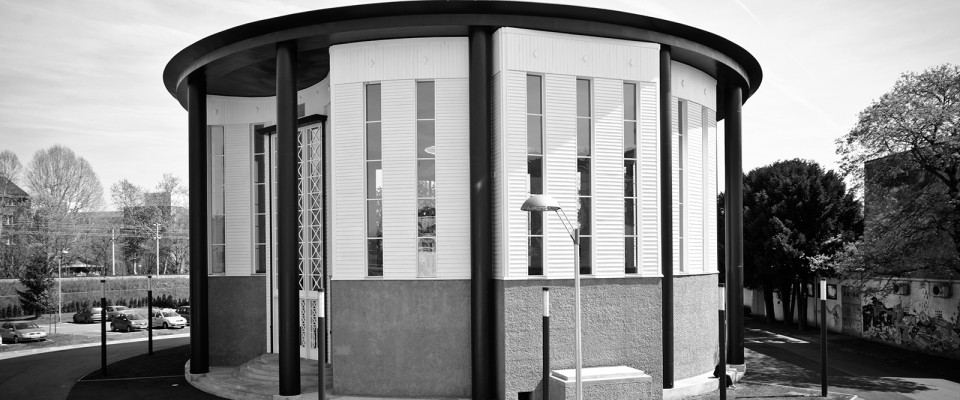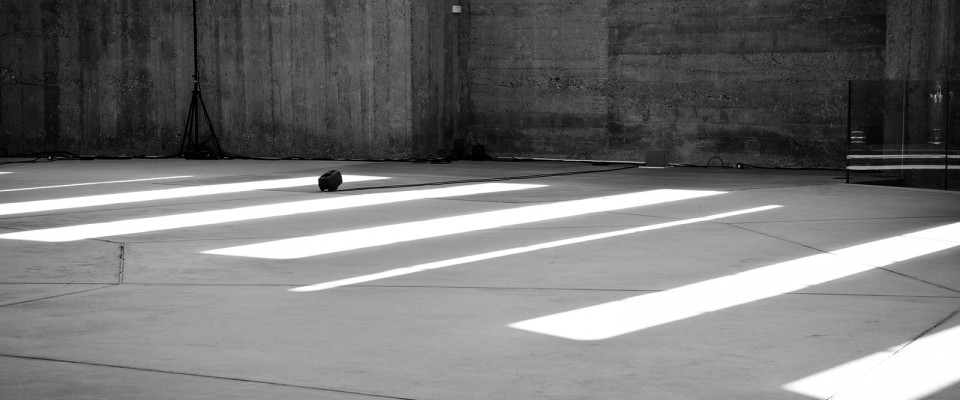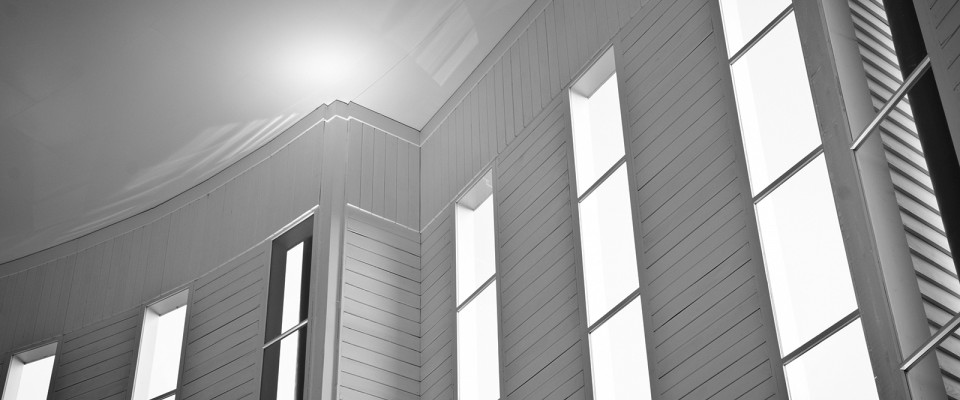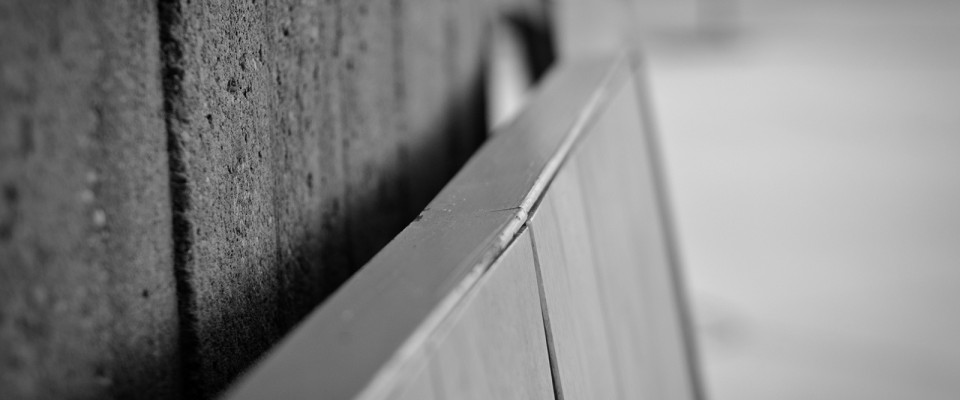{ FOR THE MUSIC BIENNALE ZAGREB - 25 SAVSKA ROAD }
The French Pavilion is the first space within the series of works {kA}: Oblivious to Gravity that is not an abandoned or vacant building at present.
But it has a very special and diverse history of use, vacancy, demolition, redesign, and rededication that makes the place not only from an architectural point of view – unique. It is also paradigmatic for the gap between the architectural idea and vision for a space created and its actual acoustic properties that create a diametric other experience of the space.
Built as a space for communication, speech, and exhibition with glass, concrete, and advanced materials to create transparency, width, and a distinguished atmosphere the building has a unique reverberation that turns every subtle sound into a floating sonic mass, a wide-spreading stream of reflections and layers of time.
Because of these unusual acoustic properties of the space that make it almost unsuitable for normal communication or concert situation that fits in any other concert hall, it should be thought of as a spatial instrument by its own means and used for spatial music, research and performance, composing for and with the building, using the very specific acoustics as a starting point for an artistic approach.
Questioning the existence and underlining the necessity of sonic architecture in everyday life is one of the main objectives within the framework of {kA}: Oblivious to Gravity.
Premiere: 18.04.2015 - 12h59 p.m.
Further concerts had been given the following seven nights at the same time.
Lecture: 20th April 2015 - 03 p.m. at the festival centre.
Curated by Davorka Begovic
{...}
{...}
Firstly, no sound event, musical or otherwise, can be isolated from the spatial and temporal conditions of its physical signal propagation. Secondly, the sound is also shaped subjectively, depending on the auditory capacity, the attitude, and the psychology and culture of the listener. There is no universal approach to listening: every individual, every group, every culture listens in its own way.[10]
The initial inspection of the pavilion is both impressive and confusing.
The building has a sacred effect when you enter it, you suddenly hold your breath and for a moment you stop at the entrance. Although it is basically a single room and bright due to the numerous windows and light diffusers, I cannot get an overview, the distance to the opposite side too far to recognize details, the panorama to the left and right too wide, and the room too high to grasp its vertical with one look.
The view travels first to the representative skylight in the middle of the roof, then into the round of the total volume at half-height, then jumps between right and left, gets lost in a blink. I am surrounded by a strangely subdued atmosphere, perhaps a little 'indoor swimming pool'. A suspicion arises in me. Then I clap and at this moment the space reveals itself in a suddenness that has never been experienced before in the course of {kA}: Oblivious to Gravity. The clapping is guided through the room in a reverb tail lasting over 6 seconds, mixed with its own reflections, superimposed, rises to the ceiling, turns, falls off, and dies. Only slowly do I move to the middle of the building. In the center, I turn and clap in the four cardinal points. The reverberation mixes with the sounds of the city, which penetrate from the outside through the membrane-like wooden and glass structures.
However, after a short period of habituation, I realize that I am standing in the middle of an architectural resonance space. Passing cars and pedestrians reverberate in the interior and lead, decomposed into frequencies, an independent life in their own time, detached from their sources.
The room is visually strong and audibly weak to the same degree. Each person entering looks to the ceiling slows down the passage, becomes devout at the architectural masterpiece. At the same time, unstrained everyday communication, conversation, and information exchange from person to person are difficult to almost impossible due to the reverberation. Groups of people cause a communicative disaster. The volume level rises automatically until the words break out of the scope of their intelligibility and distort in the ear. The transparent and permeable character of the architecture turns against the visitor. This huge room is fragile, its vulnerability not immediately obvious, but its instability perceptible shortly after entering. The train tracks to the left and right, which pass by the building at a distance of approx.150 meters, run passenger and transport trains past the Student Center grounds as scheduled. The sound propagation of the vehicles strokes like cello arches at the pavilion, which is then flooded by a house-high sound wave, transforms the sounds in its interior and moves through the volume. And even moments after the trains can no longer be seen through the windows of the building, their reverberation tails travel as streaks through this acoustic storage of memories.
I explore the outside area over several days, learn the different bird voices, rhythms of the traffic flows of the adjacent streets, take pictures, and begin the systematic walk according to the principles of the building-sound composition.
In the following days, I have the floor hatches to the cellar chambers permanently opened. The passageways look like flute slots in the vibrating floor made of concrete elements. Over a period of two weeks, I test the reverberation paths and sound discolorations, as well as the acoustic bridges of the building, and record the results in the logbook.
After days of detailed room surveys with the issit, I mounted three loudspeakers above the entrance doors with the help of a very shaky ladder at a height of eight meters each, erected a five-meter high tower of four subwoofers with the help of the theatre technicians and installed 22 more loudspeakers in the basement rooms (four), the toilets (two) and with tripods and supports at different heights and angles in the main hall.
For a particularly long time, I experimented with a triangular constellation of lying loudspeakers, which were placed in the center of the building and thus directly under the skylight. This made it possible to use the ceiling as a parabolic reflector and, depending on the distribution of energy, rhythm, and material, to fill the room from above, even though the sources were on the floor. In this way, the building could also be perceptibly differentiated in sound at different heights.
[10] Augoyard, J.-F. and Torgue, H. ›Sonic Experience, A Guide to Everyday Sounds‹, McGill-Queen’s University Press 2005, p.10.
The environment can be considered as a reservoir of sound possibilities, an instrumentarium used to give substance and shape to human relations and the everyday management of urban space.[11]
The compositional response was to make use of the acoustic attributes of the building and its surroundings. It was important to understand the pavilion as acoustic architecture: It was used as a resonance body, colour generator, filter, sound material, and spatial material.
After the extensive tests of the previous days, however, it had also become clear that for a differentiated space-sound composition, the audience had to be distributed at least predominantly to different listening islands in order not to challenge the instability of the acoustic space completely unpredictably by walking around freely. Seating was therefore incorporated into the compositional idea at an early stage as part of the artistic setting. This means that I composed with my laptop from the chair islands, composed and adjusted the sound phenomena occurring at different listening points. It was also important that the chairs were far enough apart so that the listening experience could be perceived by the respective visitor more as a personal spatial experience and less as a set concert. The various seating islands were articulated as invitations to the audience, no one was forced to sit.
Simon Emmerson's theory of dynamic sound-field frames12 as a possible acoustic subdivision of a perspective space was implemented processual: Areas of interest are either local and thus divided into event and stage, or field and divided into arena and landscape.[12]
Francoise Bayle's 'region of influence' also plays a strong role here. »If a line shifts, it defines the space where the line has moved, that is a plane.«[13].
Since the cylindrical building blurs the sound events inside and out, an attempt was made to create transitive and spatial spaces in space. This was initially done by developing more stable sound trajectories derived from the clicking and creaking noises of the constantly working building material. (These 'working noises' of the window frames, hinges, and wood paneling increased in density with increasing outside temperatures. This means that on warmer days the pavilion plays a livelier song).
According to Certeau14, spaces are created by movement, among other things. However, these must have a high degree of traceability and direction. The illusion of the impossible flight according to Emmerson has three attributes: perspectival, direction and partition. Through the high attraction of individual, impulsive and transient sounds (clicks, bursts), the ear jumps between two spatially and temporally separated events and can also be directed to a third and fourth. If these movements are coordinated with the reverberation time, the ear alone can be tempted to wander through the building with very few and minimal settings.
Each event generates a reverberation tail, which informs the listener of its location and the condition of the building as well as the time traveled – active echolocation as a compositional tool. In addition, based on the material studies, time-invariant sound centers were arranged at different positions in the horizontal and vertical auditory field. These were derived and transformed by the drones of rail and road traffic that are repeatedly formed in the building, as well as the deep whistling noises generated by the wind under the door slits of the portals. Their dropout, in turn, produced extreme reverberation tails and thus led the ear down from high energy levels with the building’s own time, dying down to the sound of the outside space, which then reappears in attention, where it loses itself, – passive echolocation as a result of the compositional setting.
With the help of the five-meter high subwoofer tower, the window fronts and floor panels could be set into vibration. Thus, in the audible range, the entire building could be used as a resonance space in terms of building-sound composition. The floor chambers were understood as independent instruments. Equipped with loudspeakers, filtered through the concrete floor slabs, the sounds could only pass through the floor hatches into the building. Like slots in wind instruments, the edges of the hatches formed the columns of sound, some of them rising with high energy, which were then divided into modulated frequency bands by the sudden reverberation, in order to be absorbed by the total volume moments later. In the course of the compositional process, there are repeated interruptions, because heavy rainfall on the metal roof makes concentrated listening almost impossible.
As in Sauraugasse 04 in 2011, the question once again arises as to how robust a building-sound composition must be. As robust as the building? How could this degree of resistance be acoustically measured or evaluated? The answer can only be given from the respective context of the building - its designation, the embedding in the urban space, the predominant acoustic architecture as the main characteristic of the location.
The pavilion is like a tank, everything flows inside it, everything sinks into it, every abrupt movement becomes liquid. The work began at Easter 2015. It was continuously developed on-site and solely from the place itself.
The result was a five-part building-sound composition with a total length of 35'52'' and the possibility to stroll for ten minutes.
The sound artistic intervention was made possible by the invitation of Davorka Begovic, curator of the Festival for Contemporary Sound – izlog and co-curator of the Zagreb Music Biennale 2015 and the Chambers for Space Inquiries.
There is an effect on any sonic operation. The physical signal is under a perceptive distortion, a selection of information and attribution of significance that depends on the abilities, psychology, culture, and social background of the listener.[15]
The general rehearsal with invited guests on 18 April 2015 had to be canceled because a stage for rock and hip-hop had been set up on the area of the Student Centre 200 meters further away and, together with the sounds of the DJs from the nearby concert halls, made the performance completely impossible until late into the night. The premiere on 19 April, scheduled at 23.59 was held with a maximum of 60 visitors and no further incidents. Another six fully booked performances took place at the same time on the following evenings. The documentary recordings of the composition were made with the Schoeps KFM 6 on different days from different listening points at different times of the day.
[11, 15] Augoyard, J.-F., and Torgue, H. ›Sonic Experience, A Guide to Everyday Sounds‹, McGill-Queen’s University Press 2005, p.8.
[12]Simon Emmerson ›Aural landscape: musical space, Organised Sound 3(2)‹: 135–40, 1999 Cambridge University Press.
[13] Franzoise Bayle ›Space and more, Organised Sound 12(3)‹: 241–249, 2007 Cambridge University Press.
[14] See in this volume: The Composed Space
The exhibition pavilion of the Republic of France was built for the fair Zagrebacki zbor in the years 1936 and 1937 at 25 Savska Road in Zagreb according to the design of the French architect Robert Camelot and the civil engineer Bernard Lafaille.
The French Pavilion represents a unique innovation in engineering, where for the first time a thin steel shell was applied as a load-bearing structure in a high-rise building. In 2003 it was listed in the Register of Cultural Assets of the Republic of Croatia.
The Pavilion is conceived as a cylindrical single-space structure of an irregular curved surface, covered with a suspended roof (la voile mince) in the shape of a reversed shallow cone 32.30 m in diameter made of trapezium steel tin panels 2 – 3 mm thick. The
roof rests at the height of 13.50 m above ground on a ring-like series of 12 steel tubular columns 80 cm in diameter and 3 mm thick, fixed on short reinforced concrete bars that stick out from the concrete base. The roof structure is stretched under the weight of the central circular skylight which also functions as a precipitation collector, while the whole structure system is stabilized by a concrete ring beam in a steel tin box, laid directly on the columns. This masterpiece of modern architecture kept its original use as an exhibition space for the latest technical achievements for a very short time. In the Third Reich, the room was used as a holding point for Jewish citizens before deportation.
At that time, the originally large inscription was still emblazoned above one of the entrances: Liberté, Égalité, Fraternité.
After the war, the building stood empty for a while. Ever since the Zagreb Fair was moved to its present location in New Zagreb in 1956, the French Pavilion has not been given more appropriate use to the present day within the Student Centre but the one of the storage of the nearby Theatre &TD. In the early 1990s, the Pavilion entered a period of relatively intensive new use as a theatrical stage. Recognized as an exceptionally valuable theatrical space, owing to the geometry of its interior, the Pavilion aroused the great interest of cultural workers.
However, the Pavilion’s poor condition questioned any further use for public performances without prior renovation. At the end of the 1990s, since the renewal did not take place, the French Pavilion was definitely closed for any kind of public use due to safety reasons and was used as storage space until 2009. Architects were able to restore the building to its original plans between 2007 and 2011.
The pavilion was conceived again as an exhibition space for various uses such as lectures, presentations, university celebrations and performances. Due to various delays in the completion and acceptance of the building, the building was not reopened until 2015.














